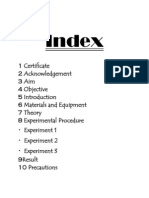0 ratings0% found this document useful (0 votes)
6 viewsAim
Aim
Uploaded by
rudrasalvix16Copyright:
© All Rights Reserved
Available Formats
Download as DOCX, PDF, TXT or read online from Scribd
Aim
Aim
Uploaded by
rudrasalvix160 ratings0% found this document useful (0 votes)
6 views13 pagesCopyright
© © All Rights Reserved
Available Formats
DOCX, PDF, TXT or read online from Scribd
Share this document
Did you find this document useful?
Is this content inappropriate?
Copyright:
© All Rights Reserved
Available Formats
Download as DOCX, PDF, TXT or read online from Scribd
Download as docx, pdf, or txt
0 ratings0% found this document useful (0 votes)
6 views13 pagesAim
Aim
Uploaded by
rudrasalvix16Copyright:
© All Rights Reserved
Available Formats
Download as DOCX, PDF, TXT or read online from Scribd
Download as docx, pdf, or txt
You are on page 1of 13
AIM:
Measuring the amount of Acetic Acid in Vinegar
by titration with. Indicator Solution.
An Objective: The goals determine acid of this
Project is to amount of Acetic in different types of
vinegar Using titration with to determine a
Colored pH indicates the end point
Introduction –
About Vinegar: -
Vinegar is Fermentation which turn Sugan a
Solution of was made from that geoethane
CCH3CH2OH), Previously fermented from. The
fermentation. Results in the of Production acid
(CH₃ COOH). There different from a types or
ethanol of acetic many Vinegars, each Starting.
different original sugar Source’s, nice, wine, salt,
etc.] of acetic acid Vany typically vinegars but in a
• The amount vinegar Can between 4 to 6 four
table UP to (18) % four pickling vinegar. Three
times higher. titration introduction: In amount this
project, I have determined the of acid a titration in
different vinegars using Common technique
Chemistry Titration measure the unknown.
Chemical in adding with solution) with a way
amount of 90 40 a Solution (the titrant) by
measured amount of Chemical known
concentration (the titrating. The titrating Solution.
titration reacts and the end point of monitored in
the titration. from and Some way. The Can not the
amount of titrating the ratio of the in the chemical
equation the reaction is Concentration. be
Calculated Solution added, two
Chemicals for the reactants.
Titration theory:
To measure Solution the acidity of we
Can add water a vinegar. Enough
hydroxyl ion.to balance out the be added
hydrogen ion .from the enact acid with
the hydroxyl ion will hydrogen ion.to
Produce Water .In anden four a titration
to work, We need three things.
1. a fitenation solution Contains hydroxyl
ion with a Precisely known
Concentration).
2. a method foun delivering a precisely
measured volume of the titrating
Solution, last
3. a means of indicating, when the end
point has been reached. Fous the
titration solution, we'll use a dilute
Solution of Sodium hydroxide (NaOH).
Sodium. Hydroxide is a Strong base
which means that it dissociates almost
completely in waters four every NaOH
molecule that we add to the Solution, we
a hydroxyl ion. Can expect to Produce
Performing titration:
To dispense an of accurately measured
volume the titrating Solution, we brunette
with a makings Volume brunette A brunette is
a will use a long tube Valve at the bottom and
graduated on the out sides to measure the
Contained in the brunette is mounted on the
ring stand, directly above the titration
Solution. Solution in the pe the brunette
tends to creep up sides of the glass. Of the
liquid tension of liquid thus meniscus liquid
the at the Sunfire
• This is due to the surface water. The
surface of the Forms a Aneasune Curve, the
called volume of the brunette always creak
from the meniscus. To in the bottom or
Indicators: In this experiment indicators
Solution Phenolphthalein Solution is the
Solution is acidic we will use a called
phenolphthalein. Colorless when the neutral.
When come slightly basics, become Phenoph
tathale in lightly purple turns pinkish, and
then as the Solution become when the
vinegary Solution. Know that the basic.
So, Stants to turn pink, cue titration is
Complete.
Apparatus: To do these experiments. We will
need the Following materials and equipment.
Vinegar three different types.
• Distilled water. Small funnel.0.5%
1.Phenolphthalein solution in alcohol’s
indication
0.1m Sodium hydroxide solution
→ 125 mL Conical Flask 25 0r 50 ml burnet
the 10 ml graduated cylinder Ring Stand
→ Bourette clamp Theory: Required amount
of be calculated using Sodium hydroxide
(NaOH) can the following Formula Molality x
molar mass x volume 1000 Molar mass of
NaOH = 40 g /mol
The acetic acid content of a be determine by
titrating a vinegar may vinegar Sample with
a solution of Sodium hydroxide of known
molas concentration (molarity)
CH3COOH (aq) + NaOH (aq) → CH3COONa
H2O
acid + base→ water+salt
At the end point in the titration stoichiometry
between the both Solution lies at lol ratio
MCH3COOH X VCN2 COOH Strength of acid
in vinegar can be determined by the
following formula Strength of acetic acid
MCH3COOH X 60 Indication:
Phenolphthalein
End point: Colorless to pink.
Experimental Procedure
Pour 1.5 ml of vinegar in an Conical Flask
2. Add distilled So that the become 20 ml.
water to dissolve the vinegar. Volume of the
Solution
3. Add 3 drops of 0.54. Phenolphthalein
solution.
4. Use the burette clamp to attach the
brunette to the ring Stand The opening at the
bottom of the burette should be just above
the height For the of the Conical flask we use
vinegar and phenolphthalein Solution
5. Use an 0.01 m Funnel to fill the burette
with Solution of Sodium hydroxide.
6. Note the starting level of the Sodium
hydroxide Solution the burette Put the
vinegar Solution to be titrated under the
burette.
7. Slowly drip the solution of Sodium
hydroxide into the vinegar Solution. Swirl the
Flask gently.to mix the Solution while
keeping the opening under neath the burette
8. At Color Same in Point a We vinegar will
see a pink Solution when the Sodium
hydroxide is added, but the Color. will quickly
mixed clay disappear as the Solution is When
this happens show the burette to drop-by-
drop and addition
9. When the vinegar solution turns pink and
cremains that color. Even the titration is
complete the brute the with mixing, Close the
tap
10. Note the reading remaining level of the
Sodium hydroxide Solution in the butterine
ban the reading bottom to the meniscus 11.
Substrate the initial level from the remaining
titura ting level to figure out Solution
12. For each titration vinegar that at least we
test, repeat the three times. How much we
have used.
Experiment: 01
Take the B. laboratory vinegar in the Conical
Flask and do the titration with NaOH as.
mentioned.
Calculations We know that
MCH3COOH* VCH3COOH =MNaOH * V NAOH
MCH3COOH =
MCH3COOH
Strength acetic acid.
Experiment 02
Take a the house hold vinegar in the Conical
Flask and do the titration with NaOH as
mention Calculations:
We know that
MCH3COOH *VCH3COOH = MNaOH *VNaOH
MCH3COOH = MNaOH* VNaOH /VCH3COOH
Strength of acetic acid.
Experiment 03.
take the wine vinegar in the conical flask
and do the titration with NaOH as mentioned.
Canulations:
We know that
MCH3COOH* VCH3COOH = MNaOH * VNaOH
MCH3COOH= MNaOH * VNaOH/ VCH3COOH
Strength of acetic acid=
Topic:
Result:
→Strength of acetic acid in laboratory
vinegar =
→Strength of acetic acid in house hold
vinegar =
Strength of acetic acid in wine vinegar =
graphically plotting various vinegar Samples
in accordance with the amount of acetic acid
Present in them we present a Stunning Order
amount of acetic acid in vinegar is
Wine Vinegar > House hold Vinegars >
Laboratory Vinegar
Precautions:
• Transiting of measured vinegar into a
measuring Flask Should be done very
Carefully.
• Measuring must be Performed care fully
• look at the meniscus of Solution at eye level
to avoid Parallax
• Look at the lowest meniscus in the light-
Colored Solution and uppers meniscus in the
dank Colored Solution because of visibility.
• Do not forget to add distilled water to the
vinegar.
You might also like
- CHEMISTRY INVESTIGATORY PROJECT of Class XIIDocument18 pagesCHEMISTRY INVESTIGATORY PROJECT of Class XIISuparna74% (195)
- Measuring The Amount of Acetic Acid in VinegarDocument14 pagesMeasuring The Amount of Acetic Acid in VinegarYashrajSaxena100% (10)
- 1) Provide The Structure of Anisole. Answer:: Chapter 19 Reactions of Benzene and Substituted BenzenesDocument69 pages1) Provide The Structure of Anisole. Answer:: Chapter 19 Reactions of Benzene and Substituted BenzenesAbbie BennettNo ratings yet
- CBSE XII Chemistry Measuring The Amount of Acetic Acid in Vinegar by Titration With An Indicator SolutionDocument17 pagesCBSE XII Chemistry Measuring The Amount of Acetic Acid in Vinegar by Titration With An Indicator Solutionsatyag24No ratings yet
- Project On Acetic AcidDocument21 pagesProject On Acetic AcidNaman Last To SurviveNo ratings yet
- CCCCCCCC C: C C C CCC CCCCCCCCCCCCCCCCCC CCCCCCCCCCCC C CC CCCCCCCCCCC C CDocument17 pagesCCCCCCCC C: C C C CCC CCCCCCCCCCCCCCCCCC CCCCCCCCCCCC C CC CCCCCCCCCCC C CRanjith KumarNo ratings yet
- Chem Investigatory ProjectDocument20 pagesChem Investigatory ProjectJasjit SinghNo ratings yet
- Gargi Dhanavade - Chemistry Project - Measuring th_240216_175554Document13 pagesGargi Dhanavade - Chemistry Project - Measuring th_240216_175554agrokirtiNo ratings yet
- Vishal Chemistry Project CompleteDocument16 pagesVishal Chemistry Project CompleteKislaya Mishra0% (1)
- Measuring The Amount of Acetic Acid in Vinegar by Titration With An Indicator SolutionDocument16 pagesMeasuring The Amount of Acetic Acid in Vinegar by Titration With An Indicator Solutionsanjaysuman59100% (1)
- Acetic Acid CBSE Project Class 12Document17 pagesAcetic Acid CBSE Project Class 12MegaAppleNo ratings yet
- Chemistry IPDocument12 pagesChemistry IPKrish DEvikarNo ratings yet
- Measuring The Amount of Acetic Acid in Vinegar by Titration With An Indicator SolutionDocument9 pagesMeasuring The Amount of Acetic Acid in Vinegar by Titration With An Indicator SolutionmagicallowNo ratings yet
- YashDocument17 pagesYashayys1821No ratings yet
- Chem Class 12 InvestigatoryDocument23 pagesChem Class 12 InvestigatoryMadhumithaNo ratings yet
- Measuring The Amount of Acetic Acid in Vinegar: Chemistry Investigatory ProjectDocument17 pagesMeasuring The Amount of Acetic Acid in Vinegar: Chemistry Investigatory ProjectShaurya TripathiNo ratings yet
- Measuring of The Amount of Acetic Acid in Vinegar Chemistry by Aditya Moharana-1Document20 pagesMeasuring of The Amount of Acetic Acid in Vinegar Chemistry by Aditya Moharana-1pattanaiksatyabatiNo ratings yet
- ViswaDocument16 pagesViswaviswakarthikeyan43No ratings yet
- Chem ProjectDocument14 pagesChem Projectramavishal3No ratings yet
- Measuring The Amount of Acetic Acid in Vinegar by Titration With An Indicator Solution CertificateDocument17 pagesMeasuring The Amount of Acetic Acid in Vinegar by Titration With An Indicator Solution Certificateblack kobraNo ratings yet
- Akash IpDocument15 pagesAkash Ipakashrock32777No ratings yet
- Measuring The Amount of Acetic Acid in VinegarDocument19 pagesMeasuring The Amount of Acetic Acid in VinegarT- ROCK100% (2)
- Umar Chem InvesDocument18 pagesUmar Chem Invesaafilaabdul13No ratings yet
- Measuring The Amount of Acetic Acid in VinegarDocument16 pagesMeasuring The Amount of Acetic Acid in VinegarMansi Jain100% (1)
- Investigatory Project KaranDocument15 pagesInvestigatory Project KaranKaran AcharyaNo ratings yet
- Chy ProjectDocument20 pagesChy ProjectRaghu nathNo ratings yet
- Acetic Acid CBSE Project Class 12Document18 pagesAcetic Acid CBSE Project Class 12Bhagat Singh RanaNo ratings yet
- Chemistry RuchiDocument18 pagesChemistry Ruchidhakadruchi21No ratings yet
- Aceticacid in VinegarDocument18 pagesAceticacid in VinegarSanyaNo ratings yet
- Lotal Potal Chemistry Project (1) (1) (1)Document22 pagesLotal Potal Chemistry Project (1) (1) (1)ankam sashankNo ratings yet
- 729 - For Merge TodayyyyDocument27 pages729 - For Merge TodayyyyPratham VashishtaNo ratings yet
- Chemistry Investigatory Project of Class XiiDocument17 pagesChemistry Investigatory Project of Class Xiiadityakumardash1974No ratings yet
- Chemistry Project To Measure The Amount of Acetic Acid in VinegarDocument9 pagesChemistry Project To Measure The Amount of Acetic Acid in Vinegarstructure123No ratings yet
- Chemistry Investigatory Project ReportDocument19 pagesChemistry Investigatory Project ReportPiyush80% (5)
- Final ChemDocument17 pagesFinal ChemSamyak OswalNo ratings yet
- ProjectDocument25 pagesProjectRupesh100% (1)
- ChemDocument29 pagesChemShubham Dvivedi50% (2)
- VinegarDocument6 pagesVinegarJulia Mikaela GarciaNo ratings yet
- Chemistry Investigatory Project: Manar Syed Xii-BDocument16 pagesChemistry Investigatory Project: Manar Syed Xii-BManar SyedNo ratings yet
- CBSE XII Chemistry Measuring The Amount of Acetic Acid in Vinegar by Titration With An Indicator SolutionDocument17 pagesCBSE XII Chemistry Measuring The Amount of Acetic Acid in Vinegar by Titration With An Indicator SolutionPyunika GoyalNo ratings yet
- Determination of Acitic Acid Content of Vinegar 10Document6 pagesDetermination of Acitic Acid Content of Vinegar 10Mohd FarhanNo ratings yet
- Sample of Chemistry ProjectDocument16 pagesSample of Chemistry ProjectSHIKHA BANSALNo ratings yet
- Shubh ProjectDocument19 pagesShubh ProjectShubh KhareNo ratings yet
- Chemistry Practical 2Document14 pagesChemistry Practical 2singhtejesh1No ratings yet
- Chemistry ProjectDocument16 pagesChemistry ProjectREETHA MEKOTHNo ratings yet
- ChemDocument17 pagesChemKashish KukrejaNo ratings yet
- Chemistry Investigatory Project Class XII Atishay JainDocument19 pagesChemistry Investigatory Project Class XII Atishay JainLalit MalikNo ratings yet
- Chem ProjectDocument26 pagesChem ProjectRupeshNo ratings yet
- Chemistry Project To Measure The Amount of Acetic Acid in VinegarDocument9 pagesChemistry Project To Measure The Amount of Acetic Acid in VinegarVivek Rai100% (2)
- Chemistry Investigatory Project of Class XiiDocument18 pagesChemistry Investigatory Project of Class XiiRyn RkNo ratings yet
- Chemistry Investigatory ProjectDocument22 pagesChemistry Investigatory ProjectSahil Bijarnia0% (1)
- Chemistry InvestigatoryDocument22 pagesChemistry InvestigatorySahil BijarniaNo ratings yet
- Advanced Pharmaceutical analysisFrom EverandAdvanced Pharmaceutical analysisRating: 4.5 out of 5 stars4.5/5 (2)
- The Chemistry of Dairy Products - A Chemical Analysis of Milk, Cream and ButterFrom EverandThe Chemistry of Dairy Products - A Chemical Analysis of Milk, Cream and ButterNo ratings yet
- Chemistry at Home - A Collection of Experiments and Formulas for the Chemistry EnthusiastFrom EverandChemistry at Home - A Collection of Experiments and Formulas for the Chemistry EnthusiastNo ratings yet
- Plant and Animal Bio-Chemistry - Including Information on Amino Acids, Proteins, Pigments and Other Chemical Constituents of Organic MatterFrom EverandPlant and Animal Bio-Chemistry - Including Information on Amino Acids, Proteins, Pigments and Other Chemical Constituents of Organic MatterNo ratings yet
- GUIDE TO MAKING MOONSHINE: A detailed step by step guide to create several kinds of moonshine recipes like a pro from homeFrom EverandGUIDE TO MAKING MOONSHINE: A detailed step by step guide to create several kinds of moonshine recipes like a pro from homeNo ratings yet
- Explosive Science Experiments for Little Chemists - Science Project | Children's Science Experiment BooksFrom EverandExplosive Science Experiments for Little Chemists - Science Project | Children's Science Experiment BooksNo ratings yet
- 2024 CHEMISTRY FORM 1 SCHEMES OF WORK .Doc..bakDocument17 pages2024 CHEMISTRY FORM 1 SCHEMES OF WORK .Doc..bakhotbytecyber991No ratings yet
- Non - Aqueous Acid - Base TitrationDocument17 pagesNon - Aqueous Acid - Base TitrationApurba Sarker Apu100% (4)
- Cambridge Pre-U Certificate: Cambridge Assessment International EducationDocument20 pagesCambridge Pre-U Certificate: Cambridge Assessment International Educationlaksh bissoondialNo ratings yet
- Amino AcidsDocument25 pagesAmino AcidsHeddy Myoi100% (1)
- FOSFA Banned List April 2016Document2 pagesFOSFA Banned List April 2016andriNo ratings yet
- Prac2 AnswersDocument8 pagesPrac2 AnswersAnna SellaNo ratings yet
- OTflp OX7 NL790 DT 4 I 4 YEDocument26 pagesOTflp OX7 NL790 DT 4 I 4 YESubhashakti BeheraNo ratings yet
- Class X ChemistryDocument3 pagesClass X ChemistryTejaswi VatsNo ratings yet
- Unique Properties of DyeDocument15 pagesUnique Properties of DyeFE MARIE FRNCISCONo ratings yet
- Zytron 500Document2 pagesZytron 500FranciscoCalquinGamboaNo ratings yet
- Chapt-7 Structure Activity Relationships - OKDocument35 pagesChapt-7 Structure Activity Relationships - OKSaifuddin AzizNo ratings yet
- Catalogo EmpaquetaurasDocument21 pagesCatalogo EmpaquetauraswilsonschmittNo ratings yet
- Towards Paired and Coupled Electrode Reactions For Clean Organic Microreactor ElectrosynthesisDocument18 pagesTowards Paired and Coupled Electrode Reactions For Clean Organic Microreactor ElectrosynthesisjorgchanNo ratings yet
- Biochem Lec M-3Document13 pagesBiochem Lec M-3GE SalenNo ratings yet
- Solution-Stoichiometry Worksheet Key PDFDocument2 pagesSolution-Stoichiometry Worksheet Key PDFQwert LimNo ratings yet
- Chemistry Form 4 PP2Document12 pagesChemistry Form 4 PP2jmwalimu81No ratings yet
- OSMOSISDocument7 pagesOSMOSISasherbrown798No ratings yet
- Bu Siti RukayahDocument135 pagesBu Siti RukayahEka MaryatiNo ratings yet
- Studies On Schiff Base With Its Complexes On Synthesis Characterization Biological ActivityDocument5 pagesStudies On Schiff Base With Its Complexes On Synthesis Characterization Biological ActivityInternational Journal of Innovative Science and Research Technology100% (2)
- C Chem-305Document1 pageC Chem-305Sadaqat AliNo ratings yet
- 73.020 Rudarstvo I Vađenje KamenaDocument22 pages73.020 Rudarstvo I Vađenje KamenaI am a CelticNo ratings yet
- Term - I I: Name: Grade: Viii (Igcse)Document23 pagesTerm - I I: Name: Grade: Viii (Igcse)AnonymusNo ratings yet
- Reviewer in OrgDocument18 pagesReviewer in OrgMichael Josh RamosNo ratings yet
- How Do You Detect Presence of Nickel in ChocolatesDocument1 pageHow Do You Detect Presence of Nickel in ChocolatesSakshi Sharma50% (4)
- E13 Nucleophilic Acyl Substitution in Synthesis of Esters FRDocument4 pagesE13 Nucleophilic Acyl Substitution in Synthesis of Esters FRChino BandonilNo ratings yet
- Biochem Expt 4 - FLDocument7 pagesBiochem Expt 4 - FLSEAN JODI M. COSEPENo ratings yet
- CONDAT FV 7131-49 - Complete - 20221115 - 1333Document1 pageCONDAT FV 7131-49 - Complete - 20221115 - 1333Narges alikhaniNo ratings yet
- Assessment 1 Form 5Document12 pagesAssessment 1 Form 5Masitah Abu BakarNo ratings yet
- 03 Bleach Oxidation HandoutDocument6 pages03 Bleach Oxidation HandoutBrian PermejoNo ratings yet

























































































